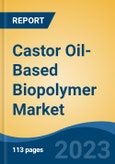Free Webex Call
Global Castor Oil-Based Biopolymer market is anticipated to grow significantly through 2028 due to growing demand from the automotive industry. In 2018, consumer goods accounted for a 28% share of the total global demand for bio-based polymers.Speak directly to the analyst to clarify any post sales queries you may have.
10% Free customizationThis report comes with 10% free customization, enabling you to add data that meets your specific business needs.
Additionally, the growing trend to minimize non-degradable polymer usage and adopt sustainable alternative solutions in the different sectors is further expected to drive market growth. Castor Oil-Based Biopolymer is a degradable, lightweight, chemical, and abrasion resistance material as bio-polymer is used in the manufacturing of automobile parts both for the interior area like the dashboard and mats as well as for the exterior area of the automobile to provide a shiny finish. Therefore, increasing production and sales of premium automobiles result in the growth of the market during the forecast period.
Furthermore, the increasing demand from the textile industry, oil & gas sector, household applications, and others are the crucial factors that propel the market’s growth. Various companies and research organizations operating in the market also focus on developing such eco-friendly products. This, in turn, is expected to create huge prospects for market growth in the coming years.
Rising demand from the Automotive Industry
Demand for environment-friendly biopolymer products is anticipated to rise due to increased public awareness worldwide and strict government restrictions aimed at promoting a carbon-neutral economy. Moreover, the expansion of market innovations is anticipated to be aided by expanding R&D efforts and rising spending. As of the rising demand for lightweight materials in the automotive sector, castor oil-based biopolymers are in big demand since they give vehicles durability and luminosity. Automobile manufacturers are adopting strategies and spending money on techniques that lighten overall vehicle weight for improved fuel efficiency. In addition, castor oil-based lightweight parts help in minimizing carbon emissions during manufacturing resulting in the demand in the forecast years.For instance, according to OICA, the manufacturing of light commercial vehicles grew to 18,593,846 units in 2021, up from 17,217,990 units in 2020.
Increasing demand from various end-user
Characteristics such as easy processing, chemical resistance, abrasion resistance, toughness, and dimensional stability result in the demand from various end users. Additionally, increasing usage of biodegradable biopolymers in sporting goods, including shoes and helmets, increases the demand for castor-oil-based biopolymers. All these factors are accelerating the castor oil-based biopolymer market growth in the upcoming years.Bio-Polyamides Will Continue to Be a Key Polymer Type
Different properties such as high thermal conductivity, high stiffness, flame resistance, low moisture assimilation, high specific strength, superior impact resilience, and chemical stability attributed to polyamide make it superior in the biopolymer. Moreover, weight reduction continues to be a significant factor in significantly reducing fuel efficiency. These factors are anticipated to increase the use of bio-polyamides in the forecast years.Recent Developments
- In October 2022, A polyester-based headrest cover called "Ultrasuede nu" was created by Toray Industries, Inc. The cover is made up of three different structures: scrim, elastomer, and ultra-fine fibers. Polyurethane substance based on castor oil makes up the elastomer.
- Arkema has benefited from robust growth for its biobased Pebax® Rnew® grades, derived from renewable castor beans in September 2022.
- Nylon grade (N510) fiber, created using only plant-based fiber, has been made commercially available, according to Toray Industries, Inc., in January 2022.
- In October 2021, a new bio-based polyamide 11 powder plant opened in China, according to an announcement by Arkema.
Market Segmentation
Global Castor Oil-Based Biopolymer Market is segmented based on polymer type, form, end user, and region. Based on polymer type, the market is categorized into bio-polyamides, bio-polyurethane, and others. Based on form, the market is segregated into pellets, yarns, and others. Based on end-user, the market is fabricated into automotive, solar, household appliances, and others. Based on region, the market is divided into North America, Europe, Asia Pacific, South America, and Middle East & Africa.Company Profiles
BASF SE, Toray Industries, Inc., Arkema S.A., Solvay S.A., Evonik Industries AG, Mitsui Chemicals Inc., DuPont de Nemours, Inc., EMS-Chemie Holding AG, Fulgar SpA, Koninklijke DSM N.V. are some of the key players of Global Castor Oil-Based Biopolymer Market.Report Scope:
In this report, the global Castor Oil-Based Biopolymer market has been segmented into the following categories, in addition to the industry trends, which have also been detailed below:Castor Oil-Based Biopolymer Market, By Polymer Type:
- Bio-Polyamides
- Bio-Polyurethane
- Others
Castor Oil-Based Biopolymer Market, By Form:
- Pellets
- Yarns
- Others
Castor Oil-Based Biopolymer Market, By End User:
- Automotive
- Solar
- Household Appliances
- Others
Castor Oil-Based Biopolymer Market, By Region:
- North America
- United States
- Mexico
- Canada
- Europe
- France
- Germany
- United Kingdom
- Spain
- Italy
- Asia-Pacific
- China
- India
- South Korea
- Japan
- Australia
- South America
- Brazil
- Argentina
- Middle East & Africa
- South Africa
- Saudi Arabia
- UAE
Competitive Landscape
Company Profiles: Detailed analysis of the major companies in the global Castor Oil-Based Biopolymer market.Available Customizations:
With the given market data, the publisher offers customizations according to a company’s specific needs.This product will be delivered within 1-3 business days.
Table of Contents
1. Product Overview
2. Research Methodology
3. Executive Summary
5. Global Castor Oil-Based Biopolymer Market Outlook
6. North America Castor Oil-Based Biopolymer Market Outlook
7. Europe Castor Oil-Based Biopolymer Market Outlook
8. Asia-Pacific Castor Oil-Based Biopolymer Market Outlook
9. South America Castor Oil-Based Biopolymer Market Outlook
10. Middle East and Africa Castor Oil-Based Biopolymer Market Outlook
11. Market Dynamics
12. Market Trends & Developments
14. Porter’s Five Forces Analysis
15. Competitive Landscape
Companies Mentioned
- BASF SE
- Toray Industries, Inc.
- Arkema S.A.
- Solvay S.A.
- Evonik Industries AG
- Mitsui Chemicals Inc.
- DuPont de Nemours, Inc.
- EMS-Chemie Holding AG
- Fulgar SpA
- Koninklijke DSM N.V.








